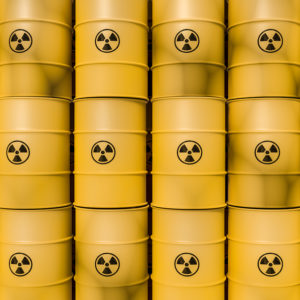If America is serious about a zero-carbon energy future, it’s hard to imagine achieving it without nuclear power. But that means getting serious about the longterm storage of nuclear waste — and there’s no sign America’s politicians have a plan to do that.
Nuclear power currently generates about 20 percent of the nation’s electricity, more than all renewable sources (wind, solar, hydropower, etc.) combined. As a result, the U.S. has more than 90,000 metric tons of nuclear waste, the vast majority spent fuel from commercial reactors, stored in casks at the reactor sites, awaiting permanent disposal.
In 1987, Congress designated Yucca Mountain — approximately 100 miles north of Las Vegas in the Nevada desert — to be the depository for all U.S. high-level nuclear waste. In 2002, President George W. Bush approved legislation for the Department of Energy (DOE) to begin construction at the Nevada site.
However, “Not in My Backyard” sentiment rapidly grew in the state, especially when Nevada Democrat Harry Reid became Senate majority leader in 2007.
The Obama administration abolished The Office of Civilian Radioactive Waste Management (OCRWM), which oversaw the Yucca Mountain project, in 2010. OCRWM officials had hoped to begin storing nuclear waste at the site by 2017.
“The reality is that the Yucca Mountain program was abandoned 10 years ago by the Obama administration and everybody knows it was abandoned for political purposes,” Paul Dickman, a senior policy fellow with Argonne National Laboratory, told InsideSources. “The hope was that the Trump administration would reestablish the infrastructure needed to search for… interim storage facilities.”
Early in his presidency, President Trump had expressed support for re-starting the Yucca Mountain project. Then politics intervened. Facing a difficult re-election campaign, Trump is hoping to collect the Silver State’s six electoral votes — he narrowly lost to Hillary Clinton by two percentage points in 2016.
Unlike his previous budget proposals, Trump’s fiscal 2021 budget plan released last month didn’t include funding for licensing of Yucca Mountain.
“Nevada, I hear you on Yucca Mountain and my Administration will RESPECT you!” Trump tweeted on Feb. 6, four days before the budget proposal was released. “Congress and previous Administrations have long failed to find lasting solutions — my Administration is committed to exploring innovative approaches — I’m confident we can get it done!”
As a result, nuclear waste stockpiling at the nation’s aging nuclear reactors will remain in storage at the plant sites, even after they are decommissioned. And plant shutdowns could be on the rise as nuclear competes with wind, solar and natural gas. The U.S. has 96 operational reactors, and eight are slated to retire in the next five years.
According to Allison McFarlane, a former head of the NRC and now director of the Institute for International Science and Technology Policy at George Washington University, disposal of high-level nuclear waste is “at an impasse in the U.S.”
“There are a number of shutdown sites and nothing is moving very quickly in terms of a final solution for this stuff,” McFarlane told InsideSources. “This is a problem. I think that there needs to be true innovative thinking — I’m not sure that it’s what the Trump administration was proposing.”
McFarlane said she was involved in an academic effort, which called on the nuclear industry to seek solutions for permanent disposal.
“One of our main recommendations to come out of this was that — actually — the nuclear industry should be managing the siting and disposal of spent nuclear fuel in the country, not the federal government,” she said. “And we made that recommendation based on looking at what other countries are doing… that have a lot more success than the U.S.”
McFarlane says the disposal program is “broken” on the financial side as well — “people who get electricity from a nuclear power plant, as part of their bill for the electricity, paid a 10th of a cent per kWh toward the nuclear waste fund.”
“Now Congress has collected a hell of a lot of money — close to $40 billion — and guess where it is? Congress is using it to offset the debt.”
David McIntyre, a spokesman for the Nuclear Regulatory Commission, says the NRC has always considered a geological site for permanent disposal of high-level nuclear waste.
“The federal policy, which we’ve always agreed with, is for permanent underground disposal in a geologic repository, such as Yucca Mountain,” McIntyre told InsideSources. “So, of course it’s up to DOE to find an alternative and Congress… to make that possible with legislation and funding.”
Rodney McCullum, senior director for fuel and decommissioning at the Nuclear Energy Institute, the nation’s nuclear energy trade association, says NEI is waiting to hear “what the administration proposes next.”
“This is an election year and we don’t anticipate any action,” McCullum told InsideSources. “In the longer term, though, there are good reasons to proceed with establishing a permanent repository.”

